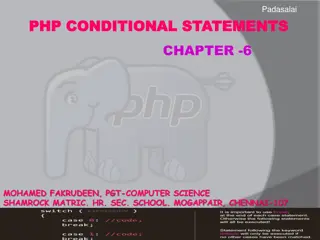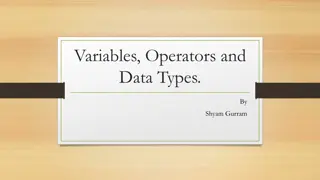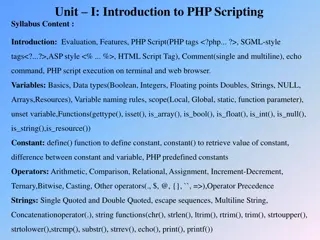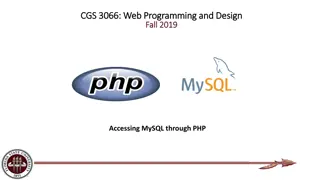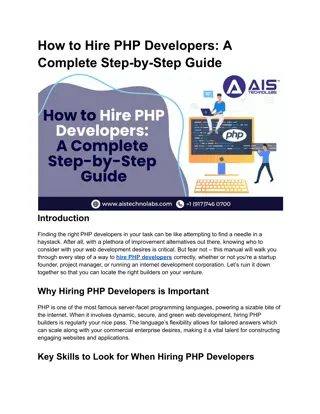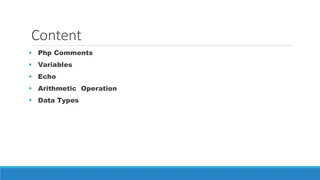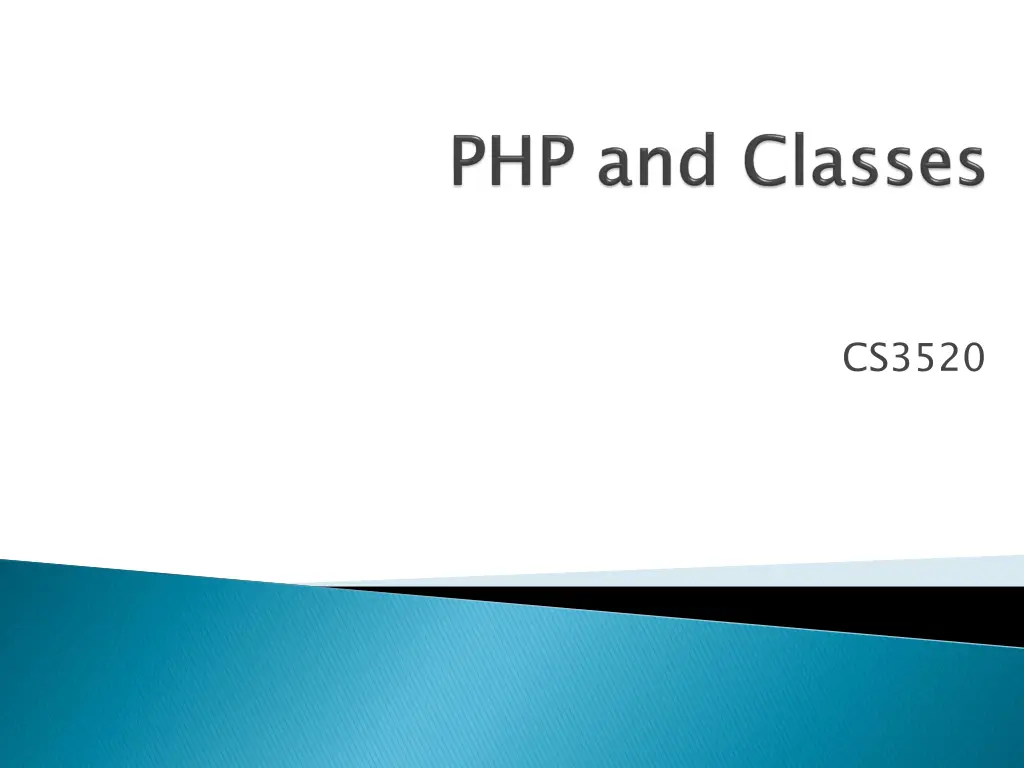
Object-Oriented Programming Concepts in PHP
Explore the fundamentals of object-oriented programming (OOP) in PHP, including class definitions, instance creation, method invocation, and variable access. Learn how classes are used to organize data and functions, without the need for explicit data type declarations. See examples of class structures and object interactions in PHP code snippets.
Uploaded on | 2 Views
Download Presentation

Please find below an Image/Link to download the presentation.
The content on the website is provided AS IS for your information and personal use only. It may not be sold, licensed, or shared on other websites without obtaining consent from the author. If you encounter any issues during the download, it is possible that the publisher has removed the file from their server.
You are allowed to download the files provided on this website for personal or commercial use, subject to the condition that they are used lawfully. All files are the property of their respective owners.
The content on the website is provided AS IS for your information and personal use only. It may not be sold, licensed, or shared on other websites without obtaining consent from the author.
E N D
Presentation Transcript
Similar to most OOP languages Again no need for declaring data types
A class is the definition used to create an instance. A class definition defines the class' name, its variables, and functions. A class definition can also contain functions used to initialize instances (constructors) and remove them (destructors).
<?php // Basic format of a class definition class ClassName { // Member variables var $variable1 = 0; var $variable2 = "String"; // Member functions function classFunction($_arg1 = 0, $_arg2) { // Function code goes here } } ?>
The keyword "class" followed by the class name is used to start the definition. Curly brackets are used to enclose all of the elements of the definition. The keyword "var" is used to identify the class' variables.
$myObject = new ClassName(); //can have constructors with arguments
<?php class theClass { // member declaration public $var = 'a default value'; // method declaration public function displayVar() { echo $this->var; } } //this is how you create an instance of $a = new //this is how you create an instance of theClass $a = new theClass theClass theClass(); (); //this is how you invoke a method on the instance $a //this is how you invoke a method on the instance $a- -> >displayVar displayVar(); (); //this is how you can access a variable in the class echo " the variable value is $a //this is how you can access a variable in the class echo " the variable value is $a- ->$ >$var var; ; ?>
In PHP, the operator "->" is used to delimit/separate the elements of an object hierarchy. For example: $myObject->class_function(); The above example refers to a function (note the parenthesis). The same format is used for properties too, i.e., $object_name->variable; Previous CODE: // $a = new Previous CODE: //this is how you create an instance of $a = new theClass this is how you create an instance of theClass theClass(); theClass (); //this is how you invoke a method on the instance $a //this is how you invoke a method on the instance $a- -> >displayVar displayVar(); (); //this is how you can access a variable in the class echo " the variable value is $a //this is how you can access a variable in the class echo " the variable value is $a- ->$ >$var var; ;
To declare a variable as private, simply replace the keyword "var" with the keyword "private" in the variable declaration. Example: private $_variable3 = 4.0; A class can also have private member functions. In this case, declare the function by putting the keyword "private" in front of the function declaration.
To declare a variable as public, simply replace the keyword "var" with the keyword "public" in the variable declaration. Example: public $_variable3 = 4.0; A class can also have public member functions. In this case, declare the function by putting the keyword "public" in front of the function declaration.
Each time an instance of a class is created, a whole new set of variables and functions for that instance is created along with it. It is possible to make it so that regardless of the number of instances of a class, only a single variable is created for that class. This allows all instances to share a single variable. To do this, replace the keyword "var" with the keyword "static" in the variable declaration.
When an instance is created, it may be necessary to go through an initialization process. This initialization process might be based on arguments passed from the code creating the instance. A function can be written for a class that is automatically called whenever an instance for that class is created. This is called a constructor.
The name of a constructor is __construct(). Example: function __construct($_arg = 0) { // Code to initialize class } That is _ _ linked together created __
It is also possible that some housekeeping or cleanup needs to be performed when an instance is removed. In this case, a destructor function is automatically called to close the instance. Destructors are only available in PHP 5. Unlike the constructor function, no arguments can be passed to the destructor function. The name of a destructor is always _ _destruct().
<?php class theClass { function __construct() { print "In constructor\n"; $this->name = "theClass"; } function __destruct() { print "Destroying " . $this->name . "\n"; } } $obj = new theClass(); ?>
class Person { var $full_name; var $birthday; var $gender; // Print function to output person's data in HTML function printPersonInHTML() { print "<p>{$this->full_name} is a "; if(($this->gender == 'M')||($this->gender == 'm')) print "male"; else print "female"; print " who was born on {$this->birthday}.</p>"; } // Class continued on next slide
// Constructor initializes values function __construct($first_name, $last_name, $gender, $birth_month, $birth_day, $birth_year) { $month_list = array ("January", "February", "March", "April", "May", "June", "July", "August", "September", "October", "November", "December"); $this->full_name = $first_name." ".$last_name; $this->birthday = $month_list[$birth_month-1]." ". $birth_day.", ". $birth_year; $this->gender = $gender; } }
The code to create an instance and call the class function printPersonInHTML() looks like this: $person_1 = new Person("John","Doe", "m", 3, 24, 1974); $person_1 -> printPersonInHTML(); The output then will be: John Doe is a male who was born on March 24, 1974.
<?php class Animal { function __construct() { print "I am an Animal\n"; } } class Dog extends Animal { function __construct() { parent::__construct(); print "and am a dog\n"; } } $a = new Animal(); $fido = new Dog(); ?>





